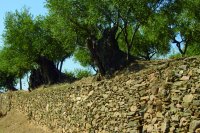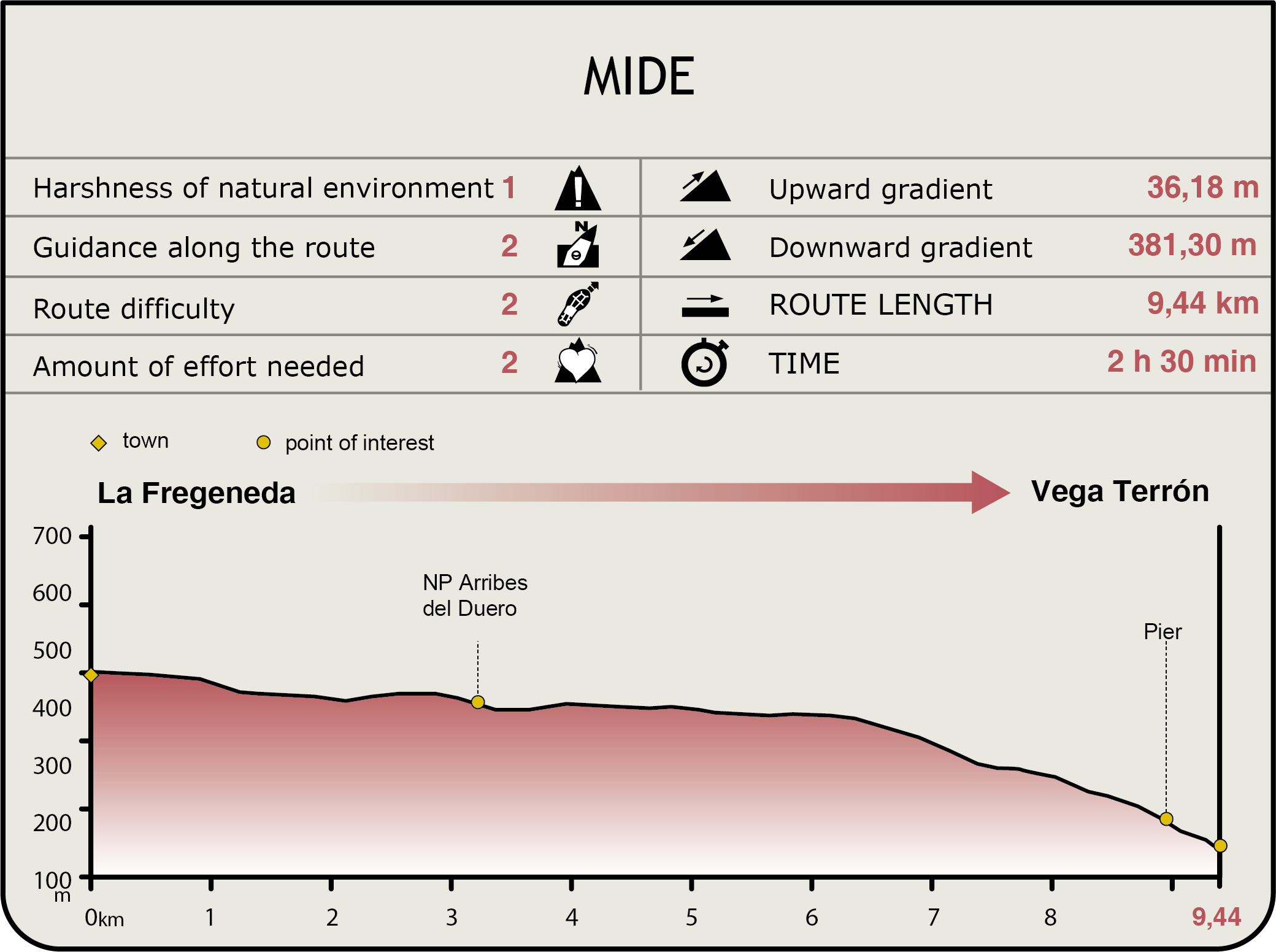Stage 42: La Fregeneda - Vega Terrón
Description

The end of the Trail
The last Stage of the Duero Nature Trail initially runs amidst olive and almond trees through an easy path adapted to the undulating topography of the terrain. This last stretch is a true natural balcony over the Arribes and the Portuguese side. One can enjoy the manicured landscape of the Portuguese fields, as well as the steep cliffs and slopes that fall into the plains in search of the backwaters of the River Duero.
Vega Terrón International Pier is the endpoint of this 750-kilometre route that covers some of the most beautiful places of the Castilian plateau and the north of the Iberian Peninsula.
The last Stage of the Duero Nature Trail begins at the Roman fountain of La Fregeneda, and ends at the river pier of Vega Terrón on the River Duero and the border with Portugal.

The landscape, dominated by olive trees, is tinged by a striking cream colour when the typically dark green leaves change their hue during the blooming cycle. The trunks, thick and gnarled, speak of the age of the trees.
The route continues to Cruz del Canto. Further on at a fork, it turns onto the path on the right known as Calzada Vieja. The wide path winds up and down the rolling flood plains, mostly populated with olive trees.
Further along the route, the path reaches the road leading from La Fregeneda to Vega Terrón International Bridge and Portugal. The route runs along this road for a few metres, and then turns onto the first path that emerges on the right, known as Calleja de Valicobo.
As the route moves forward, the olive trees give way to almond groves (Prunus dulcis). Although the trees seem unhealthy and old, they produce almonds every year. The almonds are used in our cuisine to make different types of sweets.
One can also see small stands of juniper (Juniperus oxycedrus) and holm oak (Quercus ilex) near the almond trees. Sheep also play an important role on farms, where they graze on stubble. Their handiwork is visible in the grass-free lands.
As the route advances, the view of the vertical walls and slope that plunge into the Portuguese side of the River Duero becomes increasingly sharper. Amidst almond trees and broom thickets (Cytisus sp.), the route moves on comfortably towards the fenced farmstead of Valicobo. One must cross a metal gate, which should be closed again. The farm grows almonds on terraced fields due to the rugged terrain that falls directly to the River Duero.

Near the gate, the route makes a sharp bend (the path that emerges from the left should be ignored) and begins a steep descent. From here, one can enjoy stunning views of the River Duero and the Portuguese slopes on the opposite side, populated with vineyards, almonds and olives. In sharp contrast with the Spanish side, where many farms have been abandoned and agriculture is becoming a thing of the past, the fields on the Portuguese side are productive and the farms are well-ploughed and terraced.
The Trail descends steeply, winding down to Valicobo, a farmhouse with a chapel that bears a close resemblance to the Portuguese "quinta". It has now been transformed into a rural tourism centre. From here, one can enjoy spectacular views of Barca de Alba Port (Portugal), popular with kayakers, and the River Duero. One can easily see cruise ships docked at Barca de Alba Port (Barca d'Alva in Portuguese). These ships cruise to the mouth of the river at Porto, taking advantage of the navigable River Duero.
From Valicobo, the route continues its descent along a concrete road amidst almond trees. At a bend on the road, the route takes the path that emerges on the right. The Portuguese countryside and the towering cliffs will no doubt compel you to slowdown the pace to enjoy the landscape.
The riparian vegetation becomes denser as the route continues its descent and reaches the river. This area plays host to species typical of thermophilic or wet areas, including strawberry trees (Arbutus unedo), willows (Salix sp.), ashes (Fraxinus angustifolia) and turpentine trees (Pistacia terebinthus). Meanwhile, the River Duero appears closer to the route. At the end of the descent, at the confluence of the rivers Águeda and Duero, a metal gate gives access to the Vega Terrón Pier car park. Here ends the last Stage and the Duero Nature Trail.
From its headwater in Sierra de Urbión to Vega Terrón, the route runs for more than 750 kilometres, through different landscapes and places: pine forests in Sierra de Urbión, juniper woodlands and vineyards along the River Duero, irrigated and rain-fed farmlands of Tierra de Campos, and oak and olive groves in Arribes del Duero.
Sites of interest
Profile

MIDE (Method for the Information of Excursions)
Featured
Further information
Fuente de San Esteban-Barca d'Alva Railroad
Closed in 1985, this railroad was one of the most important gateways into Portugal from Salamanca. The section between La Fregeneda station and Vega Terrón International Bridge is especially noteworthy. This section, with 20 tunnels and 13 metal bridges, and one of the most beautiful within Arribes, was declared a Property of Cultural Interest.
The actual difficulty of this engineering work, inaugurated in 1887, stemmed from the gradient between Valdenoguera, the last Spanish station at La Fregeneda, and Barca d'Alva: a difference of 330 metres.
After nearly a century in operation, and following its closure, apathy and neglect have taken their toll on this unique railroad. The stations are derelict, and the tunnels and bridges are increasingly dilapidated and in dangerous conditions.
Vega Terrón International Pier
Vega Terrón Pier, La Fregeneda's river port, is close to the mouth of the River Águeda where it empties into the Duero.
The original pier, built circa 1860 for transporting goods (mainly agricultural products), was extremely busy until the construction of the railroad in the late nineteenth century.
The current pier, built in the 1980s to revitalise the underdeveloped economy along the border, sought to take advantage of the navigable waters of the Duero and boost freight traffic, as Portugal had already done. However, it is only used by cruises ships for tourists who wish to visit Porto.

